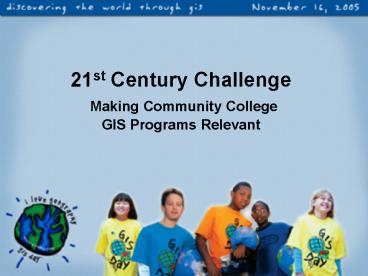21st Century Challenge Making Community College GIS Programs Relevant - PowerPoint PPT Presentation
1 / 29
Title:
21st Century Challenge Making Community College GIS Programs Relevant
Description:
Taught as integrative tool to support traditional fields, like Geography, ... Provide framework for support via an affiliate Academy program ... – PowerPoint PPT presentation
Number of Views:20
Avg rating:3.0/5.0
Title: 21st Century Challenge Making Community College GIS Programs Relevant
1
21st Century Challenge Making Community
CollegeGIS Programs Relevant
2
Dr. Phillip Davis
- Director, GIS-TECH Project (NSF)
- Professor, Computer Science, Del Mar College,
Corpus Christi, Texas
3
Challenges
- Course Ownership (Academic or Occupational)
- Articulation (K-12 and University)
- Lack of recognized certification
- Funding (GIS is relatively expensive)
4
Challenges
- Course Ownership who teaches GIS?
- Traditionally taught in Arts and Science leading
to an AA degree (geography, geology, forestry,
etc.) - Recently co-opted by Occupational programs
leading to an AAS degree (IT, CIS, etc.)
5
Advantages of AA Degree
- Required courses, therefore enrollment rarely a
problem - Taught as integrative tool to support traditional
fields, like Geography, Geology, Forestry, etc.
6
Disadvantages of AA Degree
- Coverage of GIS is too shallow in technical depth
- Students desiring to major in GIS may not be
prepared with sufficient GIS skill set
7
Advantages of AAS Degree
- Depth of GIS technology allows technician-level
training - Students prepared to solve GIS applications
- Transfer to Bachelor Science programs in GIS is
more likely
8
Disadvantages of AAS Degree
- Specialized natural of courses can make them
difficult to sustain in numbers of students - Transferability is limited to specialized
Bachelor degrees at select universities
9
Challenges of AAS Degree
- Sustaining viable programs is difficult
- Specialized nature of GIS degree limits its local
workplace market appeal - GIS programs are expensive in terms of equipment
and software costs
10
Challenges of AAS Degree
- Lack of national certification hampers
transferability among schools and universities - Serving local workforce needs precisely.
- Do technicians need AAS or certificate degree?
- Is there a large enough local need to support an
ongoing GIS program?
11
K-12 Articulation
12
K-12 Articulation
- Is GIS a mandated essential skill in your state?
- Can you provide cost-effective teacher
preparation for local school districts? - How can you support and sustain your local school
teachers with technical help and professional
development?
13
One K-12 Solution
- Create a GIS Academy program
- College acts a regional leader with multiple
school districts chartered as local academies
14
GIS Academy Model
15
GIS Academy Components
- Articulation agreement between schools and
college - Affiliation fee and contract to support teacher
training and technician - Teacher training and certification
16
GIS Academy Components
- 1. Articulation agreementlocal high school GIS
courses are articulated to community college
since course outcomes are identical and teachers
are certified by the college to meet accrediting
requirements. Articulation may be either
Tech-Prep or Dual Credit.
17
GIS Academy Components
- 2. Annual affiliate fee to support GIS technician
and teacher training - Affiliate fee provides free teacher training to
all GIS courses and technical support on site.
Our fee is 2500 and supports a single 32,000
per year technician.
18
GIS Academy Components
- 3. Teacher certificationteachers complete exact
same GIS courses as college students with 85 or
better to become GIS Level 1 certified.
Certificate consists of 4 college courses
totaling 15 semester hours.
19
K-12 Summary
- Provide clear articulation path for both teachers
and students - Provide framework for support via an affiliate
Academy program - Provide sustainability through an affordable
affiliation fee
20
University Articulation
- Aligning AAS and BS curriculums is difficult at
best. - Each level has core requirements that often
conflict.
21
University Solution
- Alignment of Program Objectives
- Crosswalk of course outcomes
- Student tracking mechanism
22
GIS Funding Opportunities
- Federal Programs Available for GIS
23
Primary Federal Funding Agencies
- National Science Foundation (NSF)
- Department of Labor (DOL)
- Department of Education (DOE)
24
National Science Foundation (NSF) Programs
- Directorate for Education and Human Resources
(EHR) - Division of Undergraduate Education (DUE)
- Advanced Technological Education (ATE)
- Course, Curriculum, and Laboratory
Improvement (CCLI) - NSF Computer Science, Engineering, and
Mathematics Scholarships (CSEMS)
25
Department of Labor
- Employment Training Administration (ETA)
- Community-Based Job Training Grants (CBJTG)
26
Department of Education
- Office of Vocational and Adult Education (OVAE)
- TECH PREP DEMONSTRATION PROGRAM
27
Grant Resources
- ESRI Grant Notification Service
http//www.esri.com/grants/index.html - ECIVIS Commercial Grant Locator
- http//www.ecivis.com
28
Questions and Comments
- What do YOU think?
29
Contact Information
- pdavis_at_delmar.edu
- 361.698.1126
- http//gistech.delmar.edu































